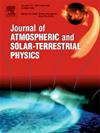Cropland classification and water stress vulnerability assessment in arid environment of Churu district, India using machine learning approach
IF 1.8
4区 地球科学
Q3 GEOCHEMISTRY & GEOPHYSICS
Journal of Atmospheric and Solar-Terrestrial Physics
Pub Date : 2025-02-24
DOI:10.1016/j.jastp.2025.106483
引用次数: 0
Abstract
The focus was to map the cropland area and assess the water stress vulnerability within the area. Cropland mapping was performed via a machine learning (ML)-based ensemble classifier (EC). The leveraging of Random Forest, Extreme Gradient Boosting, and Support Vector Machines (RF, XGB, and SVM) models using Landsat 8 data of period 2022–23. The key inputs for the models included the spectral indices such as Normalized Difference Vegetation Index (NDVI), Normalized Difference Water Index (NDWI), Enhanced Vegetation Index (EVI), Soil Adjusted Vegetation Index (SAVI), Modified Soil Adjusted Vegetation Index (MSAVI), and Land Surface Temperature (LST) in the pre- and post-harvest period of both rabi and kharif crops. Kendall tau-b trend analysis (1991–2023) of the same indices was performed to estimate the long-term changes. The water stress was modeled via the generalized additive model (GAM). The EC identified 11,600.01 km2 of cropland and 2254.32 km2 of non-cropland, with a more than 90 % F1 score, 92.5% overall accuracy, and a Kappa coefficient (0.84). The trends show significant positive change for NDVI, EVI, and NDWI, while LST increased. The GAM demonstrated a strong fit, with an adjusted coefficient of determination (R2) of 0.89. Model diagnostics show an R2 (0.79). The five-fold cross-validation confirmed the model's robustness. Moran's I analysis reveal a significant spatial clustering. The study concludes that water stress is influenced by spatially correlated factors, providing a framework for targeted crop management efforts in the area of Rajasthan, India.
基于机器学习方法的印度Churu地区干旱环境耕地分类与水分胁迫脆弱性评价
重点是绘制农田分布图,并评估该地区的水资源压力脆弱性。农田制图通过基于机器学习(ML)的集成分类器(EC)进行。利用2022-23年期间Landsat 8数据的随机森林,极端梯度增强和支持向量机(RF, XGB和SVM)模型。模型的关键输入包括归一化植被指数(NDVI)、归一化水分指数(NDWI)、增强植被指数(EVI)、土壤调整植被指数(SAVI)、改良土壤调整植被指数(MSAVI)和地表温度(LST)等光谱指数。采用Kendall - tau-b趋势分析(1991-2023)对这些指标进行长期变化估计。采用广义加性模型(GAM)对水分胁迫进行建模。欧委会确定了11,600.01平方公里的耕地和2254.32平方公里的非耕地,F1得分超过90%,总体准确率为92.5%,Kappa系数为0.84。NDVI、EVI和NDWI呈显著正变化趋势,而LST呈上升趋势。GAM显示出很强的拟合性,调整后的决定系数(R2)为0.89。模型诊断显示R2(0.79)。五重交叉验证证实了模型的稳健性。Moran的I分析揭示了显著的空间聚类。该研究的结论是,水资源胁迫受到空间相关因素的影响,为印度拉贾斯坦邦地区的针对性作物管理工作提供了一个框架。
本文章由计算机程序翻译,如有差异,请以英文原文为准。
求助全文
约1分钟内获得全文
求助全文
来源期刊

Journal of Atmospheric and Solar-Terrestrial Physics
地学-地球化学与地球物理
CiteScore
4.10
自引率
5.30%
发文量
95
审稿时长
6 months
期刊介绍:
The Journal of Atmospheric and Solar-Terrestrial Physics (JASTP) is an international journal concerned with the inter-disciplinary science of the Earth''s atmospheric and space environment, especially the highly varied and highly variable physical phenomena that occur in this natural laboratory and the processes that couple them.
The journal covers the physical processes operating in the troposphere, stratosphere, mesosphere, thermosphere, ionosphere, magnetosphere, the Sun, interplanetary medium, and heliosphere. Phenomena occurring in other "spheres", solar influences on climate, and supporting laboratory measurements are also considered. The journal deals especially with the coupling between the different regions.
Solar flares, coronal mass ejections, and other energetic events on the Sun create interesting and important perturbations in the near-Earth space environment. The physics of such "space weather" is central to the Journal of Atmospheric and Solar-Terrestrial Physics and the journal welcomes papers that lead in the direction of a predictive understanding of the coupled system. Regarding the upper atmosphere, the subjects of aeronomy, geomagnetism and geoelectricity, auroral phenomena, radio wave propagation, and plasma instabilities, are examples within the broad field of solar-terrestrial physics which emphasise the energy exchange between the solar wind, the magnetospheric and ionospheric plasmas, and the neutral gas. In the lower atmosphere, topics covered range from mesoscale to global scale dynamics, to atmospheric electricity, lightning and its effects, and to anthropogenic changes.
 求助内容:
求助内容: 应助结果提醒方式:
应助结果提醒方式:


